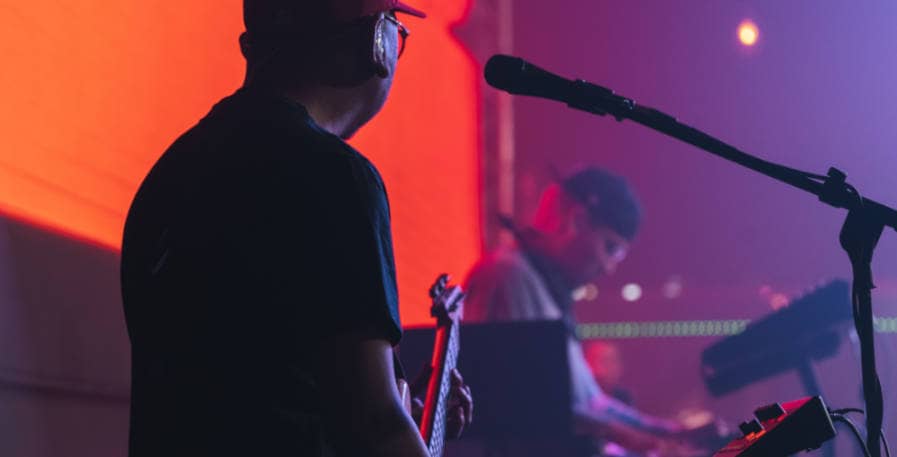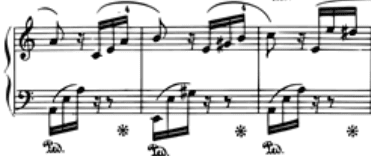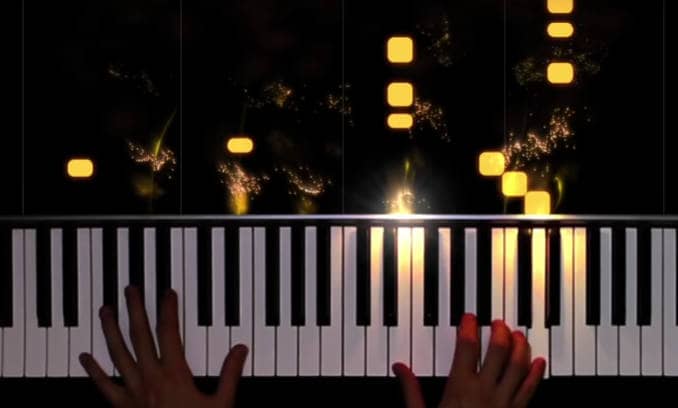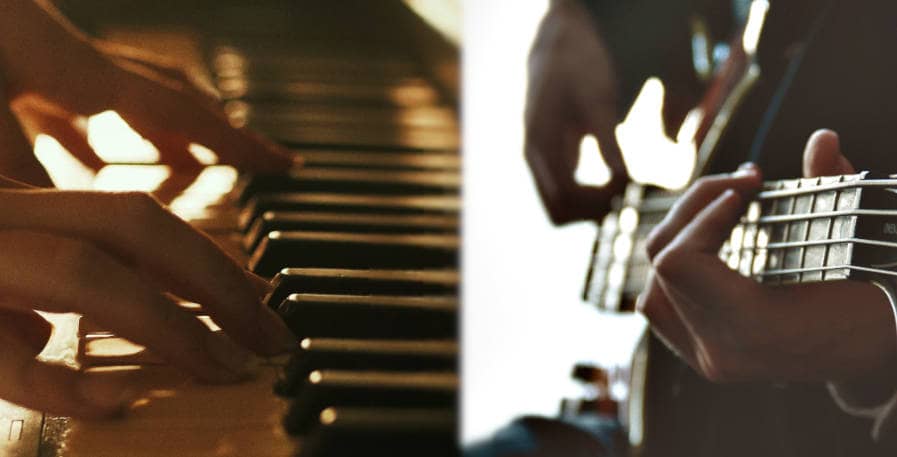There are many obvious differences between the piano and the bass guitar. There are also some more subtle differences, as well as some often-overlooked similarities.
Therefore, I decided to make an in-depth comparison of the piano and bass guitar.
I started out my musical career with a keyboard 16 years ago and have played Piano on and off since then. I`ve also played the bass as my main instrument since I got my first 4-string 15 years ago.
Thus, I feel well-equipped to tell you all about the subtle similarities and differences between the two instruments.
Below, I`ll show you in what cases you`d want to play one over the other. If you want to play both the piano and bass, I`ll also round out the article by going over the pros and cons of doing so.
The difference between Piano and Bass Guitar
It`s easy to tell that the piano and bass are vastly different instruments, simply by looking at them. However, there is some overlap in what the two instruments do and how they are played.
To get a better feel for this, here is a list of the key characteristics of both instruments side by side:
| Piano (88 keys) | Bass Guitar (4-string, 20 frets) | |
| Used to play: | Melodies and bass lines simultaneously | Bass lines |
| Main role in bands: | Melody. Chords. Harmony. | Playing low-end grooves. Bridging rhythm and harmony |
| Right-hand uses: | 5 fingers | Generally 2-3 fingers, a pick, or the thumb and 1 finger |
| Left-hand uses: | 5 fingers | 4 fingers for fretting and the thumb for support |
| Melodic Range: | A0 – C8 | E1-D#4 |
| Frequency Range: | 27.5Hz – 4186Hz | 41.2Hz – 311Hz |
| Cost of entry-level instrument: | $3000+ for a Grand Piano ($100-$300 for a keyboard) | $100-$250 |
| As a composing tool | Excellent | Mediocre |
| As a solo Instrument | Excellent and commonly used as such | Adequate and rarely used as such. |
| In Demand: | Low demand in bands, low-medium demand for session work | High demand in bands, Medium-High demand for session work |
| Height: | ~ 50-60″ (1.27m-1.52m) | ~ 46.5″ (1.18m) |
| Width: | ~58″ (1.47m) | ~14” (35.5cm) |
| Weight: | 400-900lb (181kg-408kg) | 8lb-10lb (3.6kg – 4.5kg) |
| Needs to be tuned: | ~ Once a year | Regularly |
| Cost of tuning: | $60-$200 | Easily done on your own for free |
| Invented: | ~1700 | The 1950s |
Is bass easier than piano?
While the piano and bass require different skill sets, the bass guitar is generally easier to learn for beginners. This is because developing basic hand coordination as a pianist is more time-consuming than playing beginner-level bass lines at an adequate level.
It`s possible to play complex music on both instruments. However, simplistic bass lines are common in most forms of music, which are less demanding to play than most piano pieces.
With that said, it takes years of practice to play even the simplest of basslines proficiently. This is because tone, articulation, dynamics, and being in sync with the other members of a band are skills that a bassist can only learn over time. This makes the bass guitar a difficult instrument to play at a high level.
The same goes for the piano. Even after becoming proficient at playing with the right and left hand at the same time, there is still room to add emotion and feel to your playing.
Thus, both bass lines and piano pieces can sound vastly different when played by two different people even if both are playing all the right notes.
Therefore, the two instruments are challenging in their own right, and require different skill sets.
Due to how the piano and bass are commonly played though, it will generally be harder for pianists to reach an intermediate level.
While the instruments are too different to compare in overall difficulty, the bass is more beginner-friendly than the piano.

Should you learn piano or bass?
Whether the piano or bass is best suited for you comes down to a range of factors.
With that said, there are some areas where one of the instruments clearly outshines the other. Therefore, consider the following if you are torn between which of them you should play:
Employment and demand
Bass players are always in high demand. This holds especially true in bands, but also when it comes to session work.
This is because the bass is not a popular instrument. At the same time, it is a staple instrument in almost every common genre of music. As guitarists, drummers, and singers all outnumber bassists, bass players thus tend to have an easy time finding people to play with.
Getting session work as a musician is going to be competitive no matter what instrument you play. However, for the same reasons as above, it is by far the easiest as a bass player.
Pianists are less sought after in bands, as the piano is not a staple instrument in most genres. There is some demand in jazz groups, and some pop and indie bands also prefer having a pianist. This demand is not negligible, but it is significantly lower than that of bassists.
Where pianists have an edge over bassists, is that there is a lot more work available as a soloist. The downside is that getting work as a solo pianist is that it will be competitive. While you won`t have to compete with other instruments, there are enough pianists that you will not always have work available.
Thus, if you are looking for a less competitive job market: play the bass guitar.
Composing music
The Piano is hands down the best instrument out there for composing music. This is because it allows you to play both bass and melody simultaneously, and up to 10 notes at once. As it has a range of A0 – C8, you are also never limited in how low or how high you can play.
“I believe in using the entire piano as a single instrument capable of expressing every possible musical idea.”
Oscar Peterson
Composing music on the bass is perfectly possible, and I use it for writing most of my music. You can write basslines, as well as melodies and chord progressions. If you become masterful at the instrument, it is also possible to play both basslines and melodies at the same time.
However, it is a very limited instrument when compared to the piano. The bass has less range and does not lend itself well to playing high melodies. You also have limited ways to voice chords, especially on a 4-string.
Lastly, it is significantly harder to play two parts at once, and even if you can pull it off you are limited in how you can go about it.
Thus, if you are looking to compose music, play the piano.
Cost
An entry-level bass and an amp are significantly more affordable than a piano.
Second-hand basses can sometimes be found for as low as $100. $200-$250 is a more realistic range for a decent and new instrument.
There are also a few additional things you need to purchase to get started playing bass. An amp, a cable, a strap, a tuner, and a pick, are all relatively affordable, and none of them is a necessity to start playing.
Therefore, a decent beginner bass will generally cost about $250 with accessories, though paying upwards of $350 is not uncommon.
Pianos on the other hand cost significantly more than basses. You will generally need to pay at least $3000 for an upright piano, with many being significantly more expensive. There is also the cost of tuning the piano, which will generally cost between $60 to $200 each year.
The startup cost can be greatly reduced by starting out on a keyboard or an electric piano. Entry-level keyboards can be purchased at approximately the same price range as bass guitars. Digital pianos tend to be cheaper than Grand Pianos but do cost a lot more than keyboards.
Thus, if you are looking for an affordable instrument to start out with, play the bass guitar
Solo VS band
While the bass can be fun to play alone, there are many instruments that are better suited for soloists. The bass guitar was designed to fill the same role as the double bass, which is a supporting role in a band or an ensemble. It also has a deep range, which is atypical for a solo instrument.
With that said, if you specifically want to be a soloist as a bass player, it is possible. Bassists like Wojtek Pilichowski and Charles Berthoud have built careers as solo bassists and have done well for themselves.
The piano, on the other hand, is an amazing solo instrument.
All of the abovementioned issues with the bass as a solo instrument are solved on the piano. There is also a market for solo pianists, as well as a rich history of music that is written for the piano.
Thus, if you are looking to play in a band, play the bass guitar.
If you are looking to play solo, play the piano.
Sheet Music
Knowing how to read sheet music is beneficial for playing both the bass and the piano. However, it is not a requirement for either.
The role of sheet music also differs quite a bit between the two instruments. Thus, it`s good to have an idea of its importance when choosing between the two instruments, or if you intend to play both.
Sheet music for bass players
Reading sheet music as a bass player is effectively a necessity for session musicians, teachers, and jazz bassists. Thus, it is best to learn how to read if you are looking to work as a bassist aside from playing in a band or as a soloist. However, you can still learn the bass and become proficient at it without knowing how to read sheet music.
Bass notation is based on the same system as the piano, but it is overall easier to read. This is because you are only reading one part, and only need to think about 1 clef at a time (more on that in a minute).
A notable difference is that the bass is a transposing instrument. This means that while the piano is written the same way it sounds, the bass sounds an octave lower than it`s written.
This does not make it harder to read sheet music, but rather the opposite. However, it is important to keep in mind if you are looking to play both the piano and bass.

Instead of notation, bassists and guitar players often rely on tabs to learn new music.
Tabs are generally easier to read than notation. Instead of notes on a clef, tabs simply use numbers that correspond to what fret needs to be played. I.e the number “4” on the D string, means you need to play the 4th fret of the D string.
While tabs are more beginner-friendly, there are downsides to them. Tabs work poorly for writing down rhythms, and thus you often need to pick the length of the notes out by ear. Most of the tabs you will find online are also fanmade, and thus often have mistakes in them.

Sheet Music for Pianists
For pianists, it is more common and somewhat expected to know how to read sheet music.
While the theory is the same as learning to read sheet music as a bassist, it is harder for a pianist in practice. This holds especially true when reading sheet music in real-time as you are playing along to a song.
The reason for this is that you generally have to read two parts at once. In addition to reading both parts, your hands need to be coordinated so that you can play both parts fluidly. This will take a good bit of practice.
Furthermore, the left and right-hand notation is written in different clefs. The treble clef (melody) is based around a G, and the lowest note on the main clef is an E. The bass clef is based around an F, and the lowest note of the clef is a G.
As a result, two melodies that look identical on the treble and bass clef will sound different. Thus, you need to get used to reading and playing music in both clefs at the same time. While this is an effective and standardized way of reading music, it is not beginner-friendly.

While useful, you do not need to know sheet music to play the piano. I highly recommend learning to read music if you are looking to play jazz or classical music, teach, or be a session musician. However, to claim that you need to know how to read sheet music to play the piano is purist and false.
There are many resources that pianists can use to learn new songs, without knowing music theory or how to read music. Here are some of the main ways you can learn the piano without it:
- Video tutorials
- Reactive Visualizers (Such as Synthesia)
- Playing by ear
- Emulate covers

Switching between bass and piano
Pianists and bassists have a unique advantage when switching between the two instruments. Namely that both are used to playing bass lines.
A bassist that tries out the piano will generally have much greater control of their left hand than a beginner. While keys are different from strings, their feel for playing bass lines will partly carry over. They might also find it more natural to groove on the 5th and octave than even some piano players do.
The piano will however require a different form of hand coordination than the bass. Thus, bass players will need to spend time developing this skill and getting used to playing melodies and chords.
Moving from the piano to the bass also carries with it some advantages. You are already used to playing basslines and melodies. Now you only have to play a bassline, which can in some ways feel like half the work.
Where a pianist will struggle at first, is getting used to plucking fretted strings and getting used to the tuning of the bass. Depending on their skill level as a pianist, their playing might also feel rigid and robotic. Thus, it can take some time to develop a sense of groove and to play dynamically.
The piano and bass are two distinct instruments that need to be learned separately. However, they will both partly aid you in learning the other through feel, hand coordination, and musical knowledge.
As a musician, they are also a great pair of instruments to learn. Together, they will teach you a wide array of skill sets, as well as expand your musical knowledge and ability as a composer.
Thus, if you want to put in extra practice in order to become a more knowledgeable and versatile musician, you can opt to play the bass and the piano.
If you care more about mastering a single instrument than developing your overall musical knowledge, focus on one instrument.
Conclusion
As you can tell by now, there are many things to consider when comparing the bass vs the piano.
In general, the piano lends itself better for composing and for solo play. The bass is a great choice for always having people to play with, for finding work, and as an easy instrument to start out with.
There is also nothing wrong with playing both. For absolute beginners though, I recommend starting out with just one of them. Picking up a second instrument becomes much easier later on when you have learned the basics of playing music. It also prevents the initial learning curve from feeling more overwhelming than it has to be.
Either way, these are my two favorite instruments, and it`s hard to go wrong with either. It`s also worth noting that picking one does not commit you to that instrument for life. Personally, I only found out that the bass was right for me after trying out the keyboard, guitar, and drums.
Thus, regardless of what you choose to play, the most important part is that you play something. With that, I hope this article was helpful in helping you decide which instrument to play.

